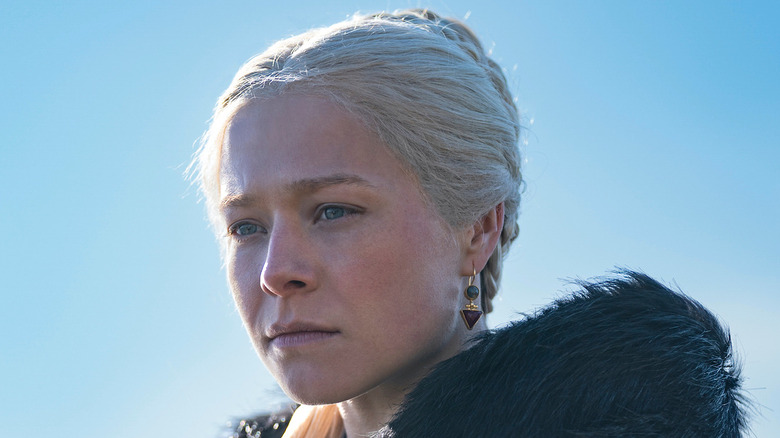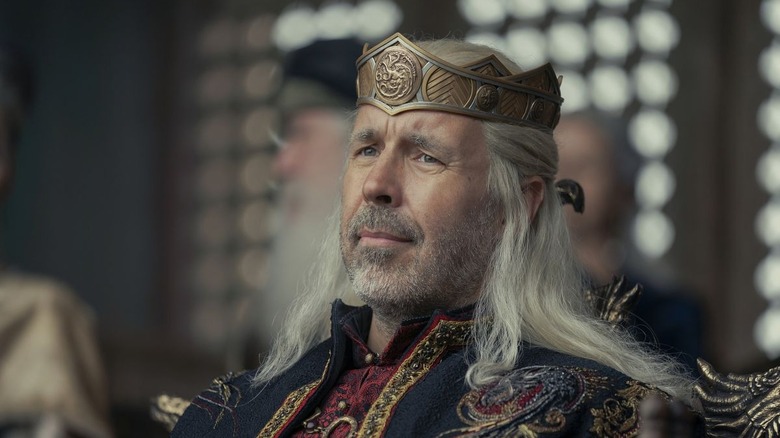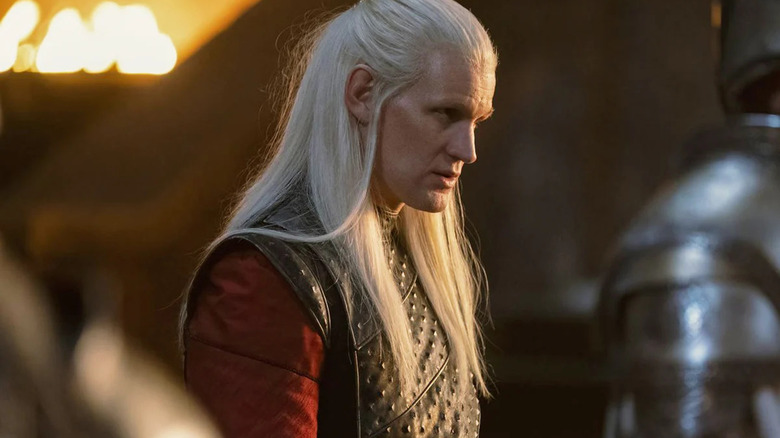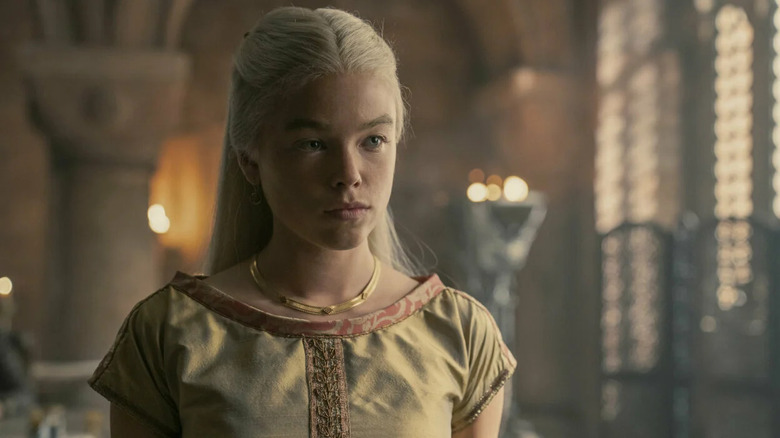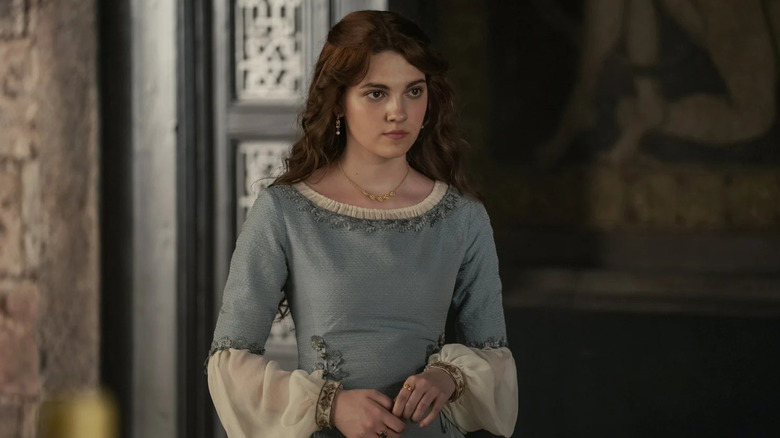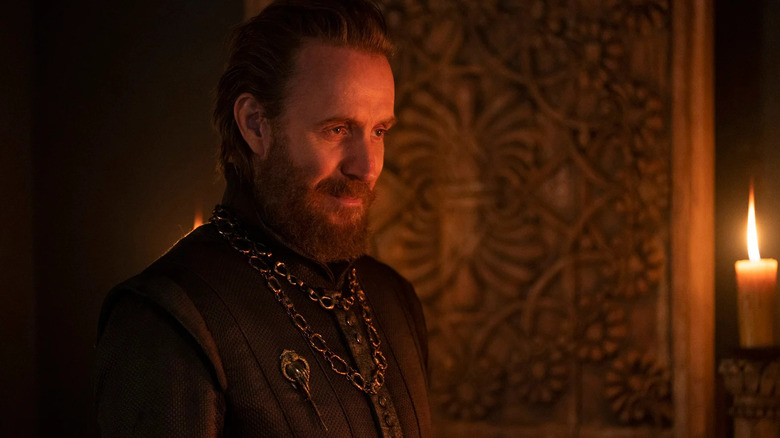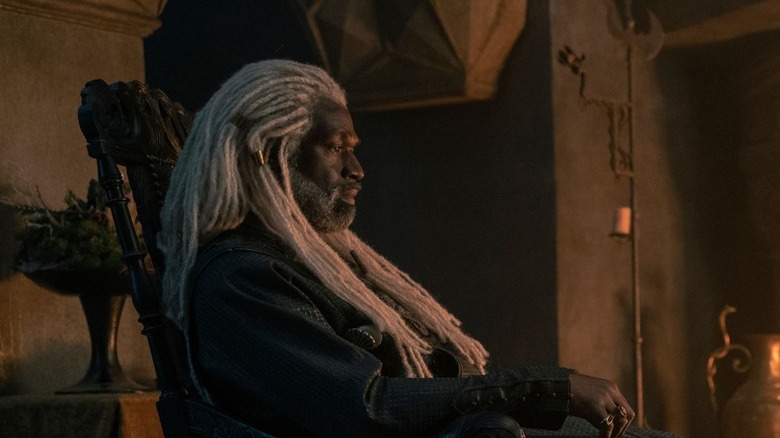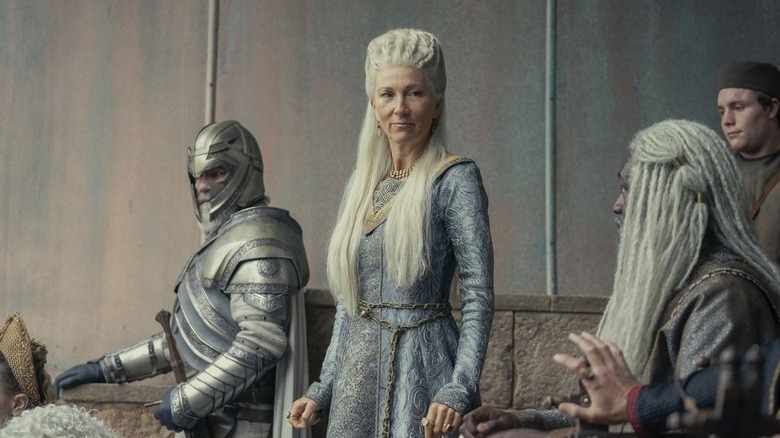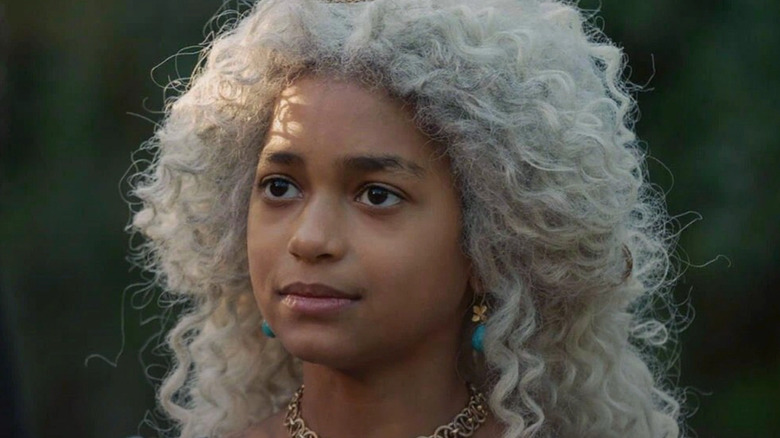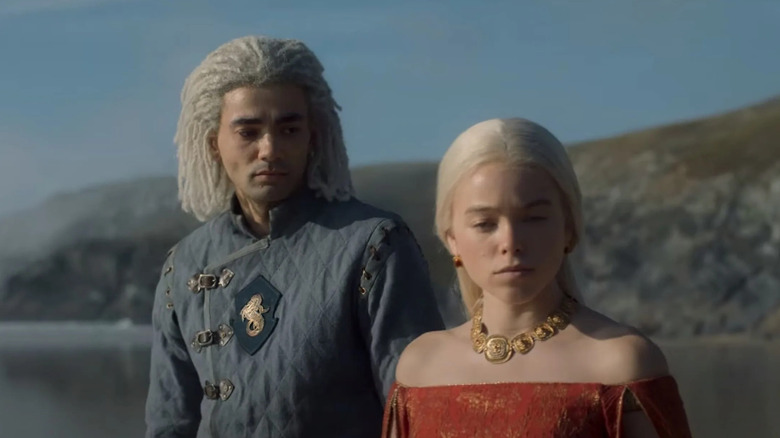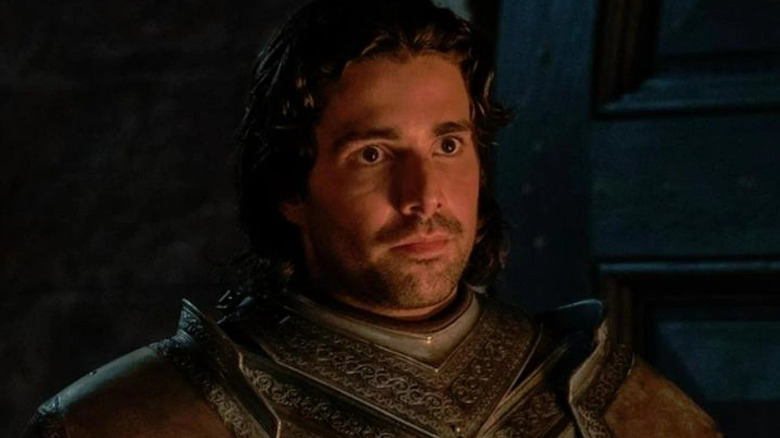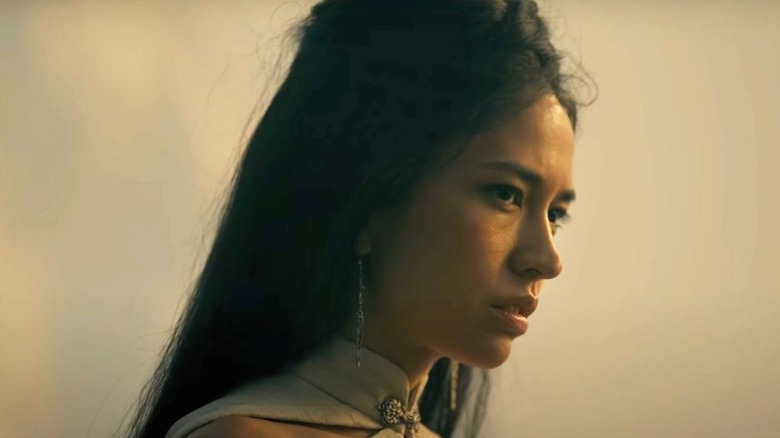What The House Of The Dragon Cast Should Really Look Like
Like "Game of Thrones," HBO's "House of the Dragon" is a small-screen adaptation of the fantasy world created by George R.R. Martin. Bringing that world to life for television presents showrunners and production designers with daunting challenges. Martin has created an entire fictional continent (and then some) with its own millennia of history, myriad risen and fallen civilizations each with their own culture, and ornate palaces and clifftop fortresses, not to mention dragons. But one of the trickiest feats to pull off is casting actors that match Martin's characters in terms of substance and style.
While "A Song of Ice and Fire" — which was the inspiration for "Game of Thrones" — switches point-of-view characters frequently and gets into painstaking detail over five volumes (so far), "Fire & Blood" — which is the source material for "House of the Dragon" — is told entirely in third person in the style of a found history. It's only as reliable as incomplete recovered documents can be, and as such, it tends to gloss over physical descriptions in favor of summaries of events. That means, in most cases, casting directors, costumers, and other creatives had more leeway in how they imagined this new crop of Westerosi royals and nobles. Still, some members of Houses Targaryen, Velaryon, Hightower, and so on have had their size, shape, age, complexion, and mannerisms changed from what Septon Eustace, Grand Maester Munkun, and court jester Mushroom tell us. Below are descriptions of the characters as they appear in "Fire & Blood" and as we see them in "House of the Dragon."
King Viserys I Targaryen
"House of the Dragon's" King Viserys (played by Paddy Considine) is a sympathetic but somewhat feckless man who, it seems, might not be as well-suited to rule as was his grandfather, King Jaehaerys. He looks weary but generally healthy, except for those pesky lacerations he sustains from sitting the Iron Throne ... the ones that, ominously, won't heal. This Viserys is in middle age and of average height and build. He's got long silvery hair and the scruffy beard of a king who isn't trying too hard to impress anybody. He wears a crown of gold and silver embossed with the Targaryen crest, and he gets a bit more dressed up for tournaments, which he enjoys planning, though not as much as he loves fiddling with his enormous model of Valyria.
While the show's Viserys is sort of a sad sack borderline beta male, "Fire & Blood's" is — like the Santa Claus of King's Landing — a rotund, jolly party king. When he ascended to the throne at age 26, he chose to wear Jaehaerys' gold crown beset with seven gemstones, each of a different color. He sported a bushy silvery gold mustache, started out pleasantly plump, and got softer and plumper throughout his reign. This Viserys really liked tourneys, feasts, balls, and any other occasion to celebrate, and the people really liked him in return because he kept the wine flowing and the entertainment going. Overindulgence caused Viserys to suffer from gout, chest pain, and other health problems that plagued him for the rest of his life. Martin describes him as "extremely fat," "red of face," and unable to walk up stairs.
Prince Daemon Targaryen
Matt Smith's Prince Daemon Targaryen is one of the breakout stars of "House of the Dragon." Smith absolutely nails Daemon's demeanor, and he's a close enough physical representation of what Martin had in mind for the Rogue Prince, who is one of Martin's favorite characters. Though "Fire & Blood" burns through its narrative much more quickly than Martin's "A Song of Ice and Fire," the author pauses to make sure we know what Daemon looks like and acts like several times. We meet him as a "hot-tempered and quarrelsome man of 20." Later descriptions pepper in terms like "impetuous," "charming," "dashing," "daring," "a renowned warrior," "lean and hard," "dangerous," and "all that his brother was not."
The written Daemon is tall and trim, like Smith, and has flowing silver hair, bold armor, and a gold cloak, just as the costume and makeup departments have styled him. Book Daemon is, however, portrayed as broader shouldered and more intimidating. And while Smith is certainly handsome in his own distinctive way, readers' impression of Prince Daemon's face is that he's so universally perceived as good looking, it's easy for women especially to excuse what Martin has called in interviews "notorious bad boy" behavior. While some of "House of the Dragon's" characters will be replaced by new actors as they age up, Daemon will be played by Matt Smith throughout. That's in keeping with the books as well, in which Daemon is a man whose personality and appearance barely change at all throughout the years.
Princess Rhaenyra Targaryen
In both the book and the show, young Princess Rhaenyra is proclaimed "the Realm's Delight." In "Fire & Blood," we first hear about her at the age of six, when she's described as "precocious," "bright," "beautiful," and "bold." She starts serving as her father's cupbearer around the age of eight, and she enjoys a close (perhaps too close) relationship with her uncle Daemon, who assures her that she's the "fairest maid in all the Seven Kingdoms." She wears her silver-gold hair in braids, prefers expensive fabrics like lace and velvet in shades of red, purple, and black, and wears a lot of jewelry. Pearls, diamonds, and rings are some of her favorites. Book Rhaenyra was shapely before motherhood, but never lost the weight she'd put on during pregnancy after childbirth. Martin calls her "stout" and "thick of waist," and says her "beauty faded by age 20."
After a brief prologue, "House of the Dragon" opens with a shot of a teenage Rhaenyra riding her dragon, Syrax, through the skies above King's Landing. The Princess of Dragonstone is an accomplished dragonrider in the books as well. It appears that production designers are using costumes — particularly colors — to convey meaning as the maturity, intentions, and allegiances of the characters. Perhaps that's why young Rhaenyra (as played by Millie Alcock) often wears pastels and uncomplicated hairstyles now. After a time jump, she's played by Emma D'Arcy, who is decked out in reds and blacks and layers of jewels, with her hair in sophisticated plaits. "House of the Dragon's" derision about Rhaenyra's size aside, D'Arcy looks physically and mentally sharp as adult Rhaenyra.
Alicent Hightower
The particulars about Alicent Hightower's physicality haven't been altered much from the source material. In both, the daughter of the Hand of the King, Otto Hightower, is depicted as traditionally feminine and exceedingly attractive ... so much so that the king turned his back on a much more politically advantageous marriage to wed her instead. Martin doesn't get into much detail about her appearance; again, he (or his fictional narrator) focuses instead on her body type. "Fire & Blood" tells us that she was "clever and lovely," "as fertile as she was pretty," and that she remained "slender and graceful" even after birthing many children.
What is dramatically different about Alicent, however, is her age and her relationship with Rhaenyra. In the book, Alicent comes to court with her father when she's already 15. At this time, Rhaenyra is only a small child. Otto began to orchestrate her rise by having her read to an ailing King Jaehaerys, who still sat the Iron Throne. Knowing what we know about the Hand of the King, whether the word "read" should be taken literally or as a euphemism is up the individual reader's interpretation. She's 18 when she and her father set their sights on King Viserys, at which point she and Rhaenyra (who have less of a relationship) are still getting along just fine. The show has aged her down so as to ramp up the drama and make her the princess' best friend before she becomes her mortal enemy.
Otto Hightower
"Fire & Blood" doesn't really tell us anything about what Ser Otto Hightower looked like. It's said that some of the Hightowers had silvery gold hair similar to Valyrian families like the Targaryens and Velaryons. But they're one of the old money houses of Westeros' Seven Kingdoms, where their family seat in Oldtown gives them access to the Citadel's library and influence over the Faith of the Seven, whose Starry Sept can also be found there. As one might expect from this Littlefinger-like ladder climber, the inner workings of his mind are of more consequence to Martin than is the face that tries to hide those schemes and plots. Otto is described as "able," "proud," and "haughty." Depending on the side with which they ally themselves, other characters either see him as learned, methodical, and blunt or as someone not to be trusted whose only goal is ever to rise above his current station.
Rhys Ifans perfectly executes Otto's subtle treachery. His even temperament comes off favorably against his rival Prince Daemon Targaryen's impulsivity. His careful word choice is evidence of his intelligence and his self-interest. We can't know for sure if Daemon actually says or does the things that the Hand of the King accuses him of. And when he tells Viserys that he does not envy him for having to marry again out of duty, it's a sly way for the King's advisor to propose instead that he marry his own daughter for love. Otto is also less flashy in his choice of dress than fellow small council member Corlys Velaryon, who — in the book and on the show — has recently surpassed him in terms of wealth.
Corlys Velaryon
The Velaryons are one of only three families to have escaped the Doom of Valyria, and they claim their roots go even farther back than the mighty Targaryens. While people of Valryian descent have been described throughout Martin's books as having silvery hair, purple eyes, and pale skin, not all of them do, and Martin doesn't bother to tell us much about what Corlys looked like. Though he's a major player in "Fire & Blood" and "House of the Dragon," most of what we know about him is contained in a few action-packed tangential paragraphs.
Martin offers that he was "as brilliant as he was restless" and "as adventurous as he was ambitious." Corlys — who goes on to become the greatest seafarer ever — is responsible for turning his house from a minor one aligned with the Targaryens into a major one that competes for a share of the Throne. The Velaryons have long served the Targaryens with their ships and as Kingsguards, but Corlys' enterprising more than doubled his family's fortune, and his marriage to Rhaenys and the birth of dragonriding Velaryon children further increased his power. However, the Velaryons were generally seen as lesser than the Targaryens.
Rhaenys Targaryen
The appearance of Princess Rhaeyns Targaryen, the Queen Who Never Was, varies even within Martin's writing. In "Fire & Blood," she's described as a great beauty who had black hair and pale purple eyes, since she bore the traits of both her Baratheon mother and her Targaryen father. She had a thin body and face into her old age, but her raven locks became streaked with white in her later years. Rhaenys was something of a wild child. She usually wore her hair down, preferring it to hang loose and fly in the wind as she rode her dragon, Meleys. Other characters note that she was "spirited" and had a "fiery temperament."
However, in Martin's 2013 novella, "The Princess and the Queen," which was later expanded into "Fire & Blood," Rhaenys is described as having the typical silvery-gold hair of a Targaryen. In both instances, however, Rhaenys is younger than she's portrayed in the series "House of the Dragon." She's 16 when she marries Corlys Velaryon, who is then in his late thirties. Eve Best and Steve Toussaint play the characters more like contemporaries on the show, and the actors themselves are only six years apart in age. So far, Best's hair has also been done up in some gravity defying feats of follicle architecture, which isn't consistent with how this formidable princess would've fashioned it herself. Book Rhaenys also sported coppery armor just as often as jacquard dresses.
Laena Velaryon
Fans likely found it shocking (but not that shocking; it is the world of "Game of Thrones," after all) when the king began to court 12-year-old Lady Laena Velaryon, the daughter of his cousin and his Master of Ships. These events occur in the show — more or less — as they do in "Fire & Blood," except Rhaenyra was quite a bit younger and Laena's competition, Alicent Hightower, was quite a bit older. But Laena was 12, and Martin explains that she "inherited the beauty of a true Targaryen from her mother," as well as her "father's adventurer's spirit." He adds that she was more interested in flying than in boys and that she had "a great mane of silver gold ringlets that fell down past her waist." In the decade that follows her fleeting flirtation with queendom, she becomes taller but stays "slender," and "surpassingly lovely."
In short, that crazy, white, curly wig is book accurate, as is her fascination with dragons. Though her parents have coached her in what to say to the king, Laena would rather hear stories about Balerion and Vhagar from Viserys, who is no longer a dragonrider and doesn't exactly share her enthusiasm for the winged beasts. We'll get to see more of Laena's beauty and beautiful personality shine through when she's played by Nanna Blondell in her early 20s. Nova Fouellis-Mose portrays young Laena in Episode 2's walk with King Viserys.
Laenor Velaryon
Corlys and Rhaenys have two children, the younger of whom (in the books; it's the opposite in the show) is Laenor Velaryon. It's Laenor and not Rhaenys who is the other candidate for the crown at the Great Council of 101 AC, when he's only seven years old. Though he obviously doesn't become king, he remains of interest because, as a former claimant, he'll make someone a good husband ... in theory. He also comes with his own dragon, an undersized but agile silvery-gray creature named Seasmoke, who we see blazing into the battlefield in Episode 3.
Laenor is talked about in "Fire & Blood" as if he is attractive. Martin says he has an "aquiline nose," "silver-white hair," and "purple eyes" (again, no skin color is mentioned). But he's not known for being stereotypically masculine. His sister Laena is described as being "almost as pretty as her brother." While the features of the other Velaryons aren't necessarily important plot points, Laenor's physical attributes do become a pivotal part of the story going forward. In the book's version, he's too young to participate in the War for the Stepstones and is still hesitant about riding Seasmoke, though he's still three years older than the woman to whom he'll eventually become betrothed, Rhaenyra.
That would make Laena about five years older than the Princess, rather than three years her junior, as it is in "House of the Dragon." Odds are their birth order was reversed to give Laenor a larger role and a reason to ride his dragon. Onscreen, we'll see different actors play Laenor in his youth (Theo Tate) and young adulthood (John Macmillan).
Ser Criston Cole
The early episodes of "House of the Dragon" make it pretty darn clear: everyone, especially Princess Rhaenyra, thinks Ser Criston Cole is a dreamboat. Just before he bests her uncle at her brother's name day tournament, he asks Rhaenyra for her favor. When he takes off his helmet, the princess and lady Alicent are taken aback by that olive skin, that wavy brunette hair, and those puppy dog brown eyes. What Criston lacks — a noble birth, bannermen, presumably money — he makes up for in smolder and real-world combat experience. It could be the latter that sways Rhaenyra to choose him for the Kingsguard, but let's be honest, it's probably the former.
Ser Criston Cole is the tall, dark, and handsome object of everyone's affection in "Fire & Blood," too, though he isn't an exact match for actor Fabrien Frankel. Martin writes that he's "a comely young knight of three and 20 years," with "pale green eyes, coal black hair, and easy charm." He's the "favorite of all the ladies at court" including Rhaenyra, who begs for him to be appointed to the post of her personal protector. She calls him her White Knight since, in the book, he wears pale armor with a white cloak. In Episode 3, that white cloak can be seen flapping in the wind as he rides after Rhaenyra in the Kingswood. In both the novel and the series, he's extremely handy with his morning star.
Mysaria
One of the consistent complaints that's been directed at "House of the Dragon" is the portrayal of the woman with whom Prince Daemon is smitten, Mysaria. Specifically, that criticism has had to do with the accent that actress Sonoya Mizuno has been asked to affect. The distractingly thick dialect is a show invention.
In both the text and the show, Mysaria is an exotic dancer and sex worker from the city of Lys who becomes Prince Daemon's mistress and confidant. In print, she is also known by the nicknames Lady Misery and the White Worm. That's because her hard life has hardened her outward appearance, which is described as "milky white." One could surmise from those adjectives that Daemon finds her attractive in the same way he might find a Targaryen attractive ... something that is alluded to when Mysaria offers to bring in another woman during their Episode 1 tryst.
Book Mysaria is said to wear a hooded cloak of black velvet and "blood-red silk." Though she's "lithe" and "lissome" in her younger days, Martin (who seems sometimes too preoccupied with the waist measurements of his female characters) writes that she thickens in older age. "House of the Dragon's" Lady Misery has black hair and a warmer skin tone, and (two episodes in) wears a cloak of white, though that may change. It should be noted that in "Fire & Blood," she is actually pregnant when Daemon steals the dragon egg intended for their baby's crib.
